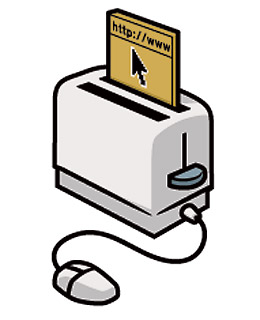The Internet of Things

It has been five years since Tim O'Reilly pitched the idea of Web 2.0. The term caught on in a big way. In fact, almost everything seems to be labeled 2.0 these days.
Recently, O'Reilly and John Battelle (they run the Web 2.0 conference - now a Web 2.0 Summit - together along with TechWeb) released a white paper called " Web Squared: Web 2.0 Five Years On."
One thing the paper examines is how the social web might intersect with the Internet of Things. Not familiar with that? Don't feel badly. It hasn't caught popular fire yet, so there's still time for you to read up and be able to chat about it at the first faculty meeting.
The Internet of Things is concerned with real world objects that are connected to the Internet. The concept of the internet of things is associated with the Auto-ID Labs. The real world objects that are connected to the Net might be household appliances, cars, books or any electronic, "smart," or RFID-enabled object.
If this sounds like something from The Jetsons, you're on the right track. Here's what was said recently on ReadWriteWeb about one smart appliance.
The Internet fridge is probably the most oft-quoted example of what the Internet of Things - when everyday objects are connected to the Internet - will enable. Imagine a refrigerator (so the story goes) that monitors the food inside it and notifies you when you're low on, for example, milk. It also perhaps monitors all of the best food websites, gathering recipes for your dinners and adding the ingredients automatically to your shopping list. This fridge knows what kinds of foods you like to eat, based on the ratings you have given to your dinners. Indeed the fridge helps you take care of your health, because it knows which foods are good for you and which clash with medical conditions you have. And that's just part of the sci-fi story of the Internet fridge.
Okay, so my home gets smarter and more connected. What about schools?
The O'Reilly paper defines "web squared" as "web meets world." (Also the idea that the web is growing exponentially.) Something that still holds over from that Web 2.0 concept from 2004 is the belief that this new web would be harnessing collective intelligence. In 2009, that now includes mobile and internet-connected objects.
Smartphones with a microphone, camera, motion sensor, proximity sensor, and location sensor (GPS) are powerful "things" that can be used in the classroom but can be taken home and into the field.
Sure, RFID tags can keep track of books in the bookstore or storeroom, but, hopefully, educators and students will come up with more than a supermarket approach to the Internet of Things.
Aren't classrooms supposed to be about collective intelligence? Isn’t intelligence, at least partially, the characteristic that allows an organism to learn from and respond to its environment?
I doubt that I will have the money to make it out to the Summit in San Francisco this October (it's by invitation), but I hope there are some educators attending (and presenting?). Schools can't afford to be left on the beach just watching another technology wave crest.
By the way, the Internet of Things is not the Web of Things. It's a very tangled web we are weaving...
Download the Web Squared White Paper (PDF, 1.3MB)
Watch the Web Squared Webcast
Comments
No comments